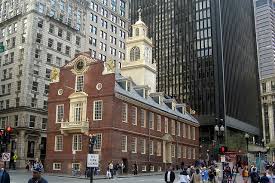
During winter break, my goal has been to write the first two chapters of my next book on Jonathan Edwards and transatlantic print culture in the eighteenth century. I am happy to say that I am halfway through completing my goal.

In my research for the first chapter, I was fascinated by some of the images of life in eighteenth-century Boston, including the "Town House" and Long Wharf. Originally built of wood in 1658, and financed largely by an estate gift of
£300 by the merchant Robert Keayne, Boston's first town house was modeled after English town houses of the same period. In an artist's rendition (pictured to the left), we can get an idea of what the first town house might have looked like in its heyday. It stood on top of piers, with merchants conducting business on the ground level, and town government taking place on the second story.

In 1711, a fire tragically destroyed the original town house. Two years later, a new building was erected on the same site and built of brick. The building cost the enormous sum of
£5,000 and measured 112 feet long by 36 feet wide on two and a half stories and featured an octagonal cupola. The basic structure still stands today and is visited by thousands of tourists each year who know it as the "Old State House."
Heading eastward on King Street (now State Street), one would have been able see a second impressive structure: Boston's Long Wharf. Constructed in 1710 and extending 1800 feet into the harbor, the wharf was lined with over fifty warehouses which served the needs of some 1,000 ships that utilized the harbor each year.

We can envision what Boston might have looked like back then from the perspective of a visitor, who described what he saw around that time:
From
the end of the Long Wharf, which lies east from the town, the buildings rise gradually
with an easy ascent westward about a mile. There are a great many good houses,
and several fine streets, little inferior to some of our best in London, the
principal of which is King’s Street: it runs upon a line from the end of the
Long Wharf, about a quarter of a mile; and at the upper end of it stands the
Town House, or Guild Hall, where the Governor meets the Council, and House of
Representatives; and the several Courts of Justice are held there also. And
there are likewise walks for the merchants, where they meet every day at one
o’clock, in imitation of the Exchange at London, which they call by the name of
Royal Exchange too, round which there are several booksellers’ shops; and there
are four or five printing-houses, which have full employment in printing and
reprinting books, of one sort or other, that are brought from England and other
parts of Europe ("Bennett's History of New England," Proceedings of the Massachusetts Historical Society 5 (1861), 110).
No comments:
Post a Comment